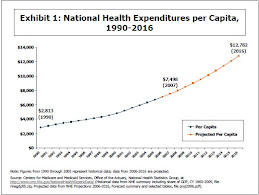According to one report from McKinsey Global Institute in 2007, prices, efficiency and insurance administration are the most important reasons U.S. spending is higher than spending in other countries in Health Care. The study estimated that relative to OECD countries, the U.S. pays 70 percent higher prices for drugs, has substantial excess capacity and low productivity in outpatient facilities, and spends six times more on insurance administration.
We can save vast sums of money (recent est. up to $350 billion) by ridding ourselves of the needless middlemen profiteers of the private fragmented health insurance industry. More than enough to cover the current 45 million uninsured.
Here is another interesting report. Dr Paul B. Ginsburg, President of the Center for Studying Health System Change, authored a new report in October 2008; "High and Rising Health Care Costs: Demystifying U.S. Health Care Spending."
The report is part of the Robert Wood Johnson Foundation's Synthesis Project. Three major drivers of health care spending, according to the findings of the study are:
• Technology—not demographics or medical malpractice—is the key driver of health spending, accounting for 38 percent to more than 65 percent of spending growth.
• Other important drivers of health care spending include health status (particularly obesity) accounting for an estimated 12 percent of the health care spending growth and
• Low productivity gains in the health care sector due to extensive third-party payment and to payment policies that reward more units of service rather than efficient care for an episode of illness.
One interesting comment from that report is that "If the efficiency of the delivery of services could be increased by 20% over 10 years, this would roughly close the gap between health care spending and GDP over that period." The bottom line is that if we want to contain our health care costs we need to find productivity improvement in things like technology use, treatment patterns, and administrative overhead.
Today, most health care reform plans focus on things like expanding the number of the insured and wellness initiatives. Those are good objectives.
But, according to Synthesis Project report, covering more people will cost more not less. Improvements in lifestyle--particularly obesity and other chronic diseases--however, might help.
But, there is another interesting Federal Report, published in January-February issue 2009 of Health Affairs. It pointed out that health care spending in U.S. grew at lowest rate in a decade in 2007. But, consumers are still paying more for out-of-pocket expenses, reports say.
Based on those reports, it is imperative that the current health care system is needed to be changed. To combat inefficiencies in health care financing, I think, a single payer model would probably help with the large majority of our troubles in financing care for every citizen. It should be a publicly financed system similar to the way Medicare is funded by our taxes. It should still stay privately delivered with our current nationwide network of physicians and hospitals and ancillary staff etc.
I'm also in favor of allocating more health care expenditure on public health education and preventative intervention like everyone has suggested.
For details of the reports, please check the following websites.
http://health.usnews.com/articles/health/healthday/2009/01/06/health-care-spending-in-us-grew-at-lowest-rate-in.html
http://www.rwjf.org/pr/product.jsp?id=35368
Subscribe to:
Post Comments (Atom)

No comments:
Post a Comment